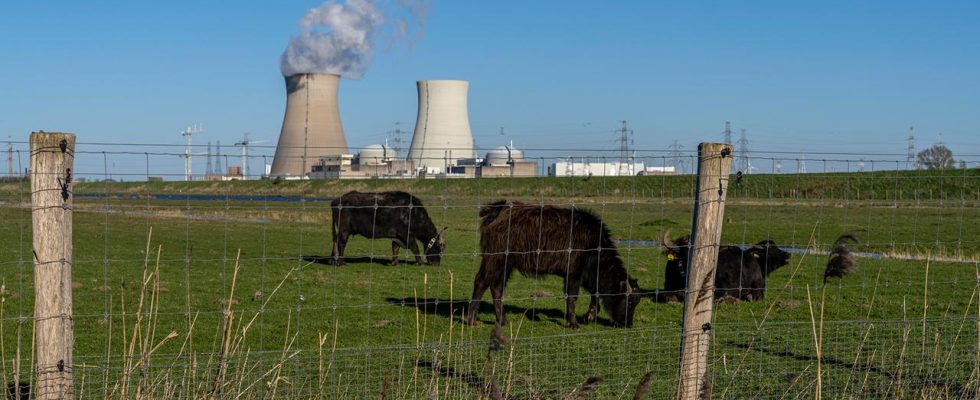The International Atomic Energy Agency and Belgium are hosting a summit today. Their goal: Nuclear power should remain a permanent part of the energy mix in Europe – thanks, among other things, to reactor technology that does not yet exist.
They want a bright future in European energy supply: About a year ago, an alliance of initially eleven European states came together to work together in the field of civil use and research of nuclear energy. The alliance has now grown to 14 members. They therefore form a majority among the EU states.
At the nuclear energy summit in Brussels today, the heads of state and government want to discuss the potential of nuclear power. Belgium, which holds the EU Council Presidency, and the International Atomic Energy Agency (IAEA) have been invited to the meeting in the run-up to the EU summit. The guests are said to include Commission President von der Leyen, French President Macron and Dutch Prime Minister Rutte.
France is expanding, Poland is just getting on board
The alliance is led by France, which gets around 65 percent of its electricity from nuclear power. The goal is to increase the installed capacity of nuclear power plants in Europe to 150 gigawatts by 2050 – an increase of around 50 percent compared to the status quo.
A total of twelve of the 27 EU member states operate nuclear power plants; nuclear power plants are currently under construction in only two countries: Slovakia and France, which plans to build six plants in the coming years. The alliance also includes the Netherlands and Belgium, which have canceled or postponed their original exit plans, and a number of Eastern European countries – including Poland, which is only planning to start using nuclear energy and is primarily hoping for a cheap energy source as an alternative to coal. Bulgaria, Finland and Romania are planning additional reactors, as is Sweden. Germany shut down its last three nuclear power plants in mid-April 2023.
The EU partly classifies nuclear energy as sustainable
The EU is divided into two camps on the issue of nuclear power. The nuclear advocates can point to some successes: The Net Zero Industry Act, the EU funding program that is intended to counteract the US Inflation Reduction Act, was opened up to nuclear energy. Under certain conditions, nuclear energy is also considered sustainable within the framework of the so-called EU taxonomy, which is intended to facilitate access to investments. This is crucial for the industry, as it can hardly survive without government subsidies.
France’s nuclear power plant operator Electricité de France is in deep trouble. The Nuclear Alliance is therefore not just focusing on future investments. It is also about securing existing projects. Mycle Schneider, editor of the annual World Nuclear Industry Status Report, points out that nuclear energy cannot hold its own in the market compared to other electricity generation technologies: “If we look at where investments have been made, then only in the solar sector are power plants in the market “An order of magnitude of 440 gigawatts has been connected to the grid. This means that massive investments are being made there.”
Reactor construction projects: expensive and lengthy
Investments in nuclear power are considered risky: estimated project costs regularly escalate. Likewise, the average construction time of ten to 15 years is usually exceeded.
A prominent current example: the Hinkley Point C twin nuclear power plant in the United Kingdom. At the start of construction, the projected costs were a good 20 billion euros. Based on today’s prices, the nuclear power plant already costs around 50 billion euros. Instead of 2025, the first of the two reactors will probably not come online until the 2030s.
Another example is the Finnish Olkiluoto III reactor block, which was originally supposed to be ready after four years, but only went online 14 years later and cost more than twice as much.
Nuclear power plants of the future: small modular reactors
An alternative nuclear power plant concept is intended to reduce risks and costs, at least in theory: so-called small modular reactors, also known as SMR, i.e. small modular reactors that only achieve an output of up to 300 electrical megawatts (MWe). For comparison: a conventional power plant achieves an average of 1200 MWe. The advantage of these mini power plants is their scaling.
Already considered as a nuclear propulsion technology for military submarines in the 1950s, small modular reactors have repeatedly come into public discussion. The hope associated with them: SMRs should be able to be built lighter, cheaper and more numerous than conventional nuclear power plants. Energy policy analyst Mycle Schneider is skeptical – because there is not a single SMR in operation yet: “These are Powerpoint reactors. For the most part, they don’t even exist on paper, but they are pretty little pictures. If we compare that with precursor developments, for example on a large scale In the pressurized water sector, one can only conclude that it takes decades until such a power plant goes online.”
Industrial Alliance the EU Commission
The most advanced project was by the manufacturer NuScale Power Corporation in the US state of Idaho, but it was stopped prematurely. Here too, the costs exceeded the original planning. The company also doubted that it would be able to find buyers for the electricity.
In the EU, the dream of SMR is not yet over: the EU Commission has launched an industrial alliance to promote it. It is intended to accelerate the introduction of small modular reactors by the early 2030s and thus also help to achieve the climate goals of the European Green Deal. Giving the SMR a boost is likely to be one of the signals that should come from today’s nuclear energy summit.

